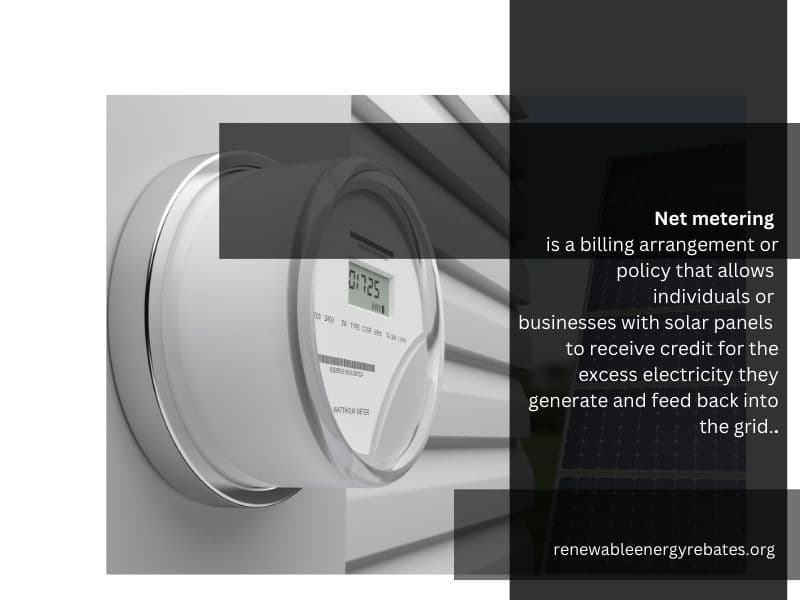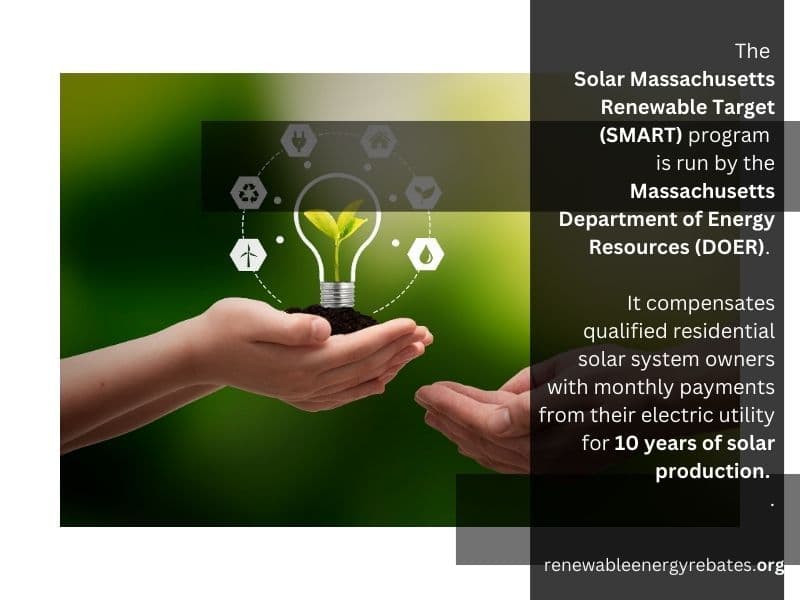Net Energy Metering in Massachusetts
Improve Savings with Net Energy Metering: What You Need to Know
Key Details
- Net Metering is a billing system that enables customers to sell excess energy produced from renewable sources into the grid.
- Facilities must be 60 kW or less for private net metering and 10 MW for public net metering.
- Customers receive credits on their electricity bill if their net consumption is negative, which can be applied in future billing cycles.
- To become eligible for net metering, customers must contact their energy provider, install a net meter, enter into a net metering contract, and monitor energy input and output.
- Various organizations help regulate net metering in Massachusetts, such as MassACA, SMART Program, and SREC program.
What is Net Metering?
Net metering is a billing system that enables you to sell excess energy to utility companies. When your photovoltaic system produces more energy than you require, you send the excess to the grid and receive credits that you can apply to future bills.
Customers of regulated electric companies in Massachusetts, such as Eversource, National Grid, or Unitil, can net meter.

Net metering permits you to produce your own electricity to mitigate your consumption. When you use electricity from the utility company, the meter advances. When you produce excess electricity and "export" it to the electric grid, your meter will turn backward.
Massachusetts does not distinguish between virtual net metering and behind-the-meter net metering. Behind-the-meter metering refers to energy generation consumed at the same location.
On the other hand, virtual net metering consists of electricity generation consumed at a site other than where the electricity is generated. Most times, including when calculating credits, there is no distinction between virtual net metering and actual net metering.
How to Enroll for Net Energy Metering in Massachusetts
Step 1. Determine your Eligibility for Net Metering.
To find out if net metering is available in your area, contact your energy provider in advance. There are caps on how much solar power can be fed into the system by some energy providers.
The solar panel system you install must also be in compliance with all regulations governing net metering. Among these are having the right features and dimensions for your property.
Step 2. Call Your Solar System Provider
Once you've established that you're eligible for net metering, the next step is to contact the company where you want to install your solar system. They will be able to assist you with the net metering setup process. They will also provide you with more information on the particular requirements and procedures for your area.

Step 3. Install a Net Meter
A net meter is a specialized electric meter that must be installed for net metering to be activated. This meter monitors both the power your solar panels produce and the power your building consumes. It monitors the difference and feeds back any power surplus to the system.
Step 4. Sign a Net Metering Agreement
After the installation of your net meter, you will need to enter into a net metering contract with your energy provider. Excess energy generated by your system will be credited to your account and applied to your monthly electricity bill in accordance with the terms and conditions outlined in this agreement.
Step 5. Keep an Eye on your Energy Consumption and Output.
It is crucial to track your energy consumption and output after implementing net metering to ensure everything is running smoothly. Electricity produced by your solar panels and electricity used by your home or company can both be monitored with a net meter.
You'll be able to monitor your progress toward lowering your electricity cost and spot any issues that may arise with this information at your fingertips.
Net Metering Facilities
According to G.L. c. 164, 138; 220 CMR 18.00, if a net metering facility is powered by solar, wind, or anaerobic digestion technology, then it must be:
- Less than 2 Megawatts (MW) for a private facility.
- Less than 10 MW for a public facility.
General Program Net Metering Caps
Public and private net metering facilities are subject to different net metering caps in the state's overall net metering program, as mandated by Massachusetts Law (St. 2010, c. 359, s. 29.00).
Each GP cap is equivalent to a percentage of the highest historical peak load for each electric business, which is the amount of electricity consumed by those customers at any given moment.
The maximum amount of energy that a given utility's customers have ever used at once is known as its peak load. This peak load is used to determine the general net metering cap for each utility.
| Distribution Company | Private Cap (7%) | Public Cap (8%) |
| Eversource | 408.24 MW | 466.56 MW |
| National Grid Massachusetts Electric Company | 359.191 MW | 410.54 MW |
| National Grid Nantucket Electric Company | 3.542 MW | 4.048 MW |
| Unitil d/b/a Fitchburg Gas and Electric Light Company | 7.14 MW | 8.16 MW |
Once a utility's net metering quota is reached, it is no longer able to accept new customers that want to join the general metering program.
Note: Even if the applicable limit is reached, facilities that are not limited by caps can still engage in net metering. Cap-exempt facilities are those with a nameplate rating of fewer than ten kilowatts on a single-phase circuit or 25 kilowatts on a three-phase circuit.
Net Metering Credit Calculation and Billing
At the end of every billing period, homeowners must pay the electric company for energy used if the net consumption is positive (220 CMR 18.03(4)). If the net consumption is negative, property owners receive a net metering credit and won't be indebted to the electric company for that billing cycle (220 CMR 18.03(3).
Note: Your bill will reflect the net metering credits as a dollar number rather than kilowatt hours. The credits carry over to the following billing month and never expire.
Calculating Net Metering Credit
Step 1. Consult the most recent pricing schedule provided by your electric provider. The host customer's rate class will decide your rate schedule (e.g., residential, commercial, etc.).
Step 2. Calculate the value of a credit for each unit of excess energy (measured in kilowatt-hours) generated by your net metering facility by plugging the values into the credit formula. Be aware that the pricing schedule for electric companies frequently changes. For instance, residential customers' basic service rates are updated every six months. The rate schedule for each electric company is also unique.
Note: The classification of your facility's net metering is determined by its type and capacity. Employ 80% of the plant's kW DC capacity to estimate the solar net metering facility's capacity.
You can use the nameplate rating if the solar net metering facility is exempt from the limitation (kW AC).
General Program
| Class Number | Size of Private Facility | Size of Public Facility |
| Class I net metering facility | 60 kW or less | 60kW or less |
| Class II net metering facility | more than 60 kW but less than or equal to 1 MW | more than 60 kW but less than or equal to 1 MW |
| Class III net metering facility | more than 1 MW but less than or equal to 2 MW | more than 1 MW but less than or equal to 10 MW |
When determining net metering credits, the following rates should not be taken into account:
- Fixed customer fees
- Charges for system benefits, such as those for renewable energy and energy optimization, also known as demand-side management charges.
- Demand charges, such as $/kW or $/kVa fees.
- The energy efficiency reconciliation factor (EERF) G.L. c. 164, § 138.
Solar Net Metering Credits
The Solar Energy Act established different metering credit values for solar net metering facilities in April 2016. Prior to the act, standard net metering credits were created by solar net metering facilities.
Under the new rules established by the Solar Energy Act, certain solar net metering facilities now generate market net metering credits.
You can determine whether your facility will produce market net metering credits or standard net metering credits by consulting 220 CMR 18.04 and Appendix A of your electric company's net metering tariff.
Net Metering and Solar Massachusetts Renewable Target (SMART)
The SMART and net metering programs are separate and are run by different organizations. A solar facility could produce net metering credits and participate in the SMART Program if it complies with both programs' requirements.
However, solar facilities cannot produce both net metering credits and alternative on-bill credits (AOBCs) simultaneously. AOBC facilities are alternatives to net metering, which the SMART program offers.

Net Metering and Solar Renewable Energy Certificates (SRECs)
There is no overlap between net metering and SRECs. A solar facility can earn both net metering credits and SRECs if it satisfies the criteria for both schemes.
As of 2023, the SREC is not accepting new solar energy installations. However, solar facilities may be eligible to join the SMART program if they are brand new.
Massachusetts System of Assurance (MassACA)
Established by the DPU, the Massachusetts System of Assurance (MassACA), in accordance with Massachusetts state law, monitors the available cap allocations. MassACA also decides who qualifies for Net Metering in relation to the private and public caps.
Within the System of Assurance, there are two net metering initiatives. Hydroelectric facilities should submit their application to the Small Hydro Program. All other net metering facilities should use the General Net Metering Program to apply.
In Massachusetts, net metering is part of a capped scheme. Securing a Cap Allocation assures facility owners and host customers that their project will receive net metering services if it fulfills the System of Assurance standards.
MassACA's Requirements for Applying for a Cap Allocation
To send in an application for cap allocation (ACA), you need to have at least the following:
- An Interconnection Service Agreement (ISA) that has been signed (i.e., signed by you and your electric company)
- Site control
- All government permits and approvals needed to build the facility, except for ministerial permits (like a building permit) and an application fee of $100.
Applications for cap allocation must be made online. Before you submit your ACA, it is recommended that you read the following documents:
- Massachusetts general laws governing net metering: M.G.L. c.164, §139(f).
- The DPU’s net metering regulations: 220 C.M.R. §18.07
- Rules governing MassACA: 11-11-D, Appendix A and
- the MassACA user help and guidance information.
Applicants Not Required to Apply for ACA
For most net metering installations, you will need a cap allocation. However, three different kinds of facilities are exempt from requesting a cap allocation:
A facility that qualifies as a cap-exempt facility under the following conditions:
- It must have a nameplate capacity of at least 10 kW on a single-phase circuit; or
- 25 kW on a three-phase circuit (220 C.M.R. 18.07). (5).
- A facility that qualifies as a cap-exempt facility under the following conditions: it must be a renewable energy generating facility as defined by DOER (G.L. c. 25A, 11F).
- a facility that was net metering prior to January 24, 2013, and is not requesting any design changes. This type of facility is also referred to as a grandfathered net metering facility.
- a facility that never intends to export energy to the grid and is offsetting its load locally.
Applicants should consult MasssACA's general program help and guidance resources for more information on what is needed to register in the System of Assurance and submit an SHP-ACA.